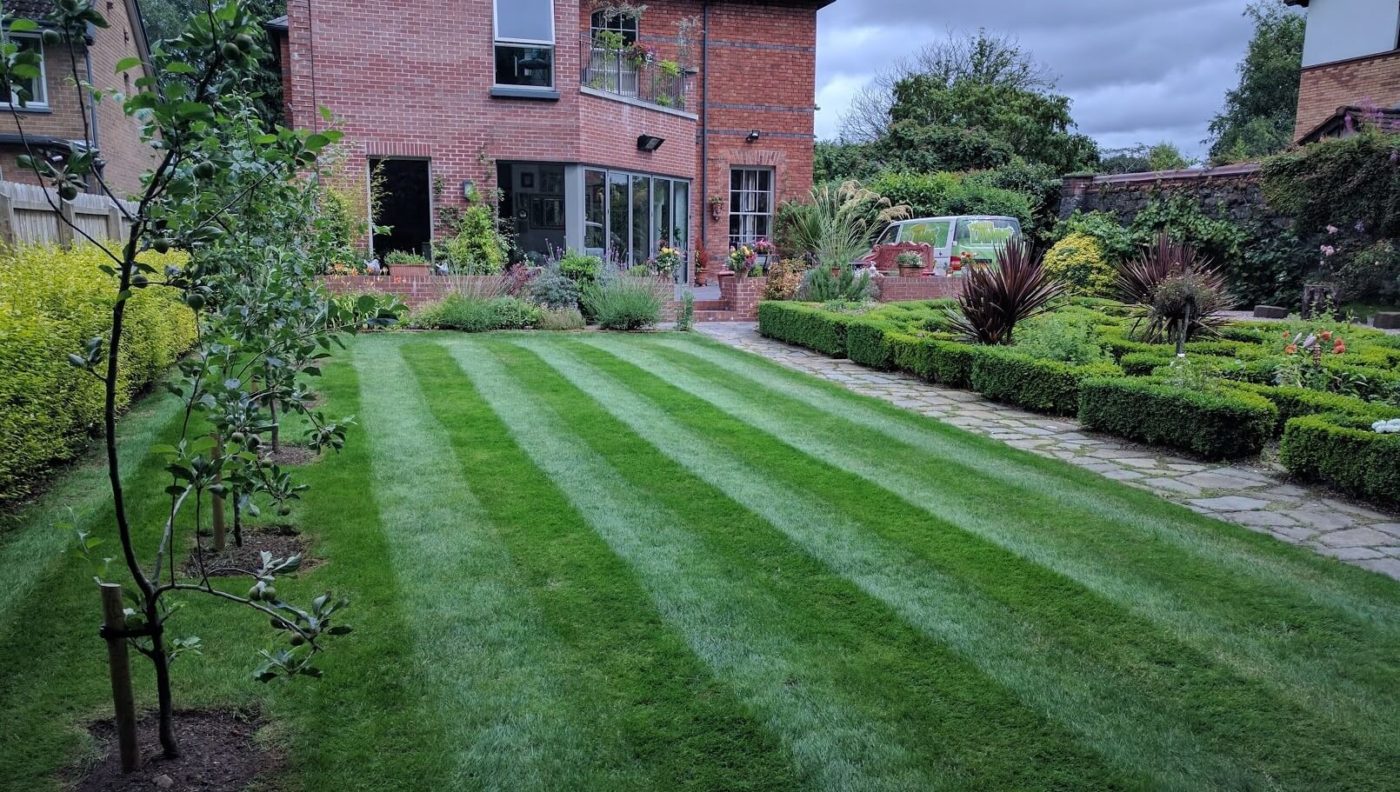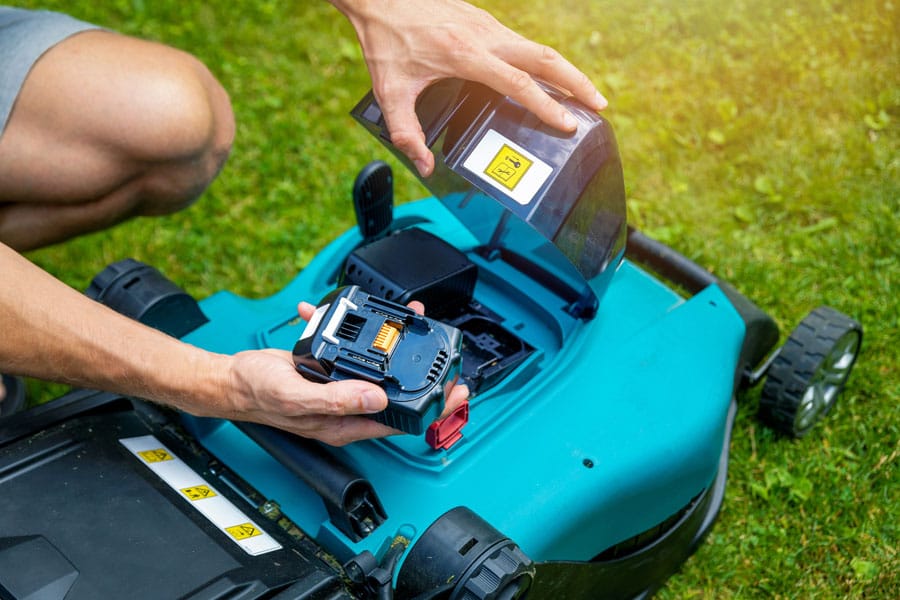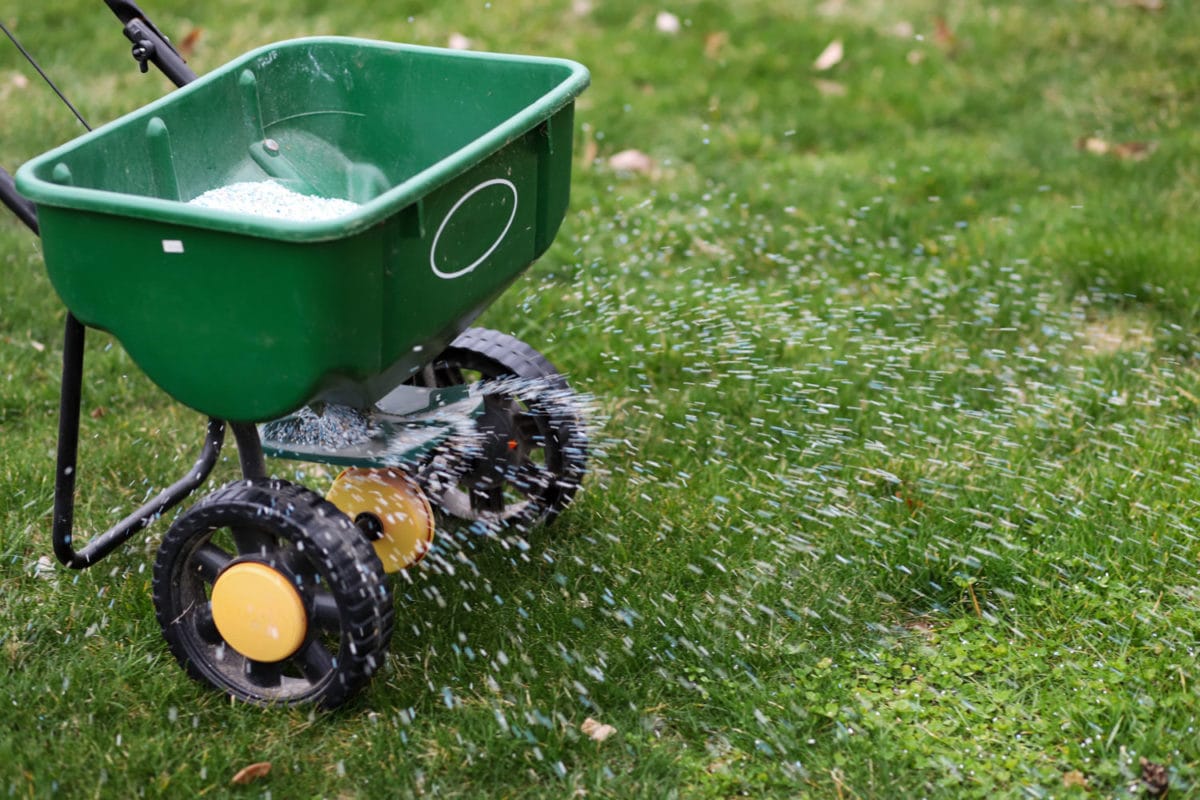How to have a lovely lawn without breaking the bank. We’re looking at lawn care on a budget.
It’s no secret, luxurious things cost money. Money to make, money to buy and money to maintain. But everyone deserves a little luxury in their lives. And if your lawn is important to you, you don’t mind splashing the cash every now and again on feeds, treatments, topdressing and machinery.
However, the cost of living is rising and somehow it feels as though we’ll have to make compromises in order to make ends meet. Some of life’s luxuries might need to be put on hold for a while. Me – I’m shelving my dreams of owning an Aston Martin DB9 and instead thinking where I can tighten the purse strings. Can I make savings and still have a lovely lawn? I’m going to do my very best to do so. How about you?

Having stripes into your lawn is a low cost way of making an ‘ordinary’ lawn look very special indeed.
What Type Of Lawn Costs Least To Maintain?
The thing about lawns is that no two are the same. In theory, the closer your lawn is to Mother Nature’s ideal for grassland, the less it will cost to maintain. So if you like the idea of a biodiverse lawn with low growing wildflowers and a very relaxed mowing regime, you can save yourself a pretty penny on lawn care.
On the other hand, a very fine, close mown, lawn is as far away from Mother Nature’s ideal as you could get. And it requires a lot of human intervention in order to keep its velvety sward looking pristine.
Somewhere in the middle of the two you have what I’d call a utility lawn. It puts up with wear and tear, won’t mind if you are a bit relaxed about maintenance and bounces back quickly after frost, heat, drought and lawn renovations.
If you need to cut back on lawn care inputs, turning a utility lawn into a biodiverse lawn is easy – it’s also easy to reverse the process when you are ready to. A fine lawn could easily be over seeded with a utility seed mix – it will look different, but it will still look good and it’ll cost you less to maintain it.
So where could you make lawn care compromises to save money, and where should you refuse to lower your standards?
Mowing

If you are planning to replace your mower – why not take a look at a battery powered version? The purchase cost is a little more than conventional mowers, but the fuel bills are negligible.
Regular mowing is key to keeping a nice thick sward on your lawn. However, regular mowing needn’t mean frequent mowing. If you are thinking about lawn care on a budget, Your species rich lawn for example, probably only needs mowing once a fortnight. On the other hand, your fine lawn might need 3-4 cuts a week in the growing season to keep it looking just-so.
Could you relax your mowing frequency just a little in order to use less fuel and therefore cut costs?
How about taking part in ‘No Mow May’ where you keep the mower in the shed and allow your lawn (or at least part of it) to do what Mother Nature intended for grass. If you hate the idea of your garden looking unkempt, consider mowing some manicured paths across the space and around the edges of your lawn. Trust me, it will look incredible.
Two aspects of mowing you should never compromise on are:
- The 1/3 rule
- Keeping those mower blades sharp
Remember too, that raising the height of your cutting bar just a notch will help your lawn cope better with extreme weather conditions. This in turn, could save you £££’s in summer watering. It will also make your lawn more resiliant to pest and diseases, potentially saving cash on chemical controls.
Feeding

I won’t lie – if you want your lawn to have a nice thick sward and a healthy green colour, you will need to feed it. But there may be savings to be had if you invest a little time in comparing different fertiliser brands and formulations.
You could also invest in a professional soil test – to check what your soil actually needs. Sometimes it’s easy to mis-diagnose a deficiency and then spend lots of money on the wrong products that won’t actually solve the problem.
Watch out for marketing tricks. Very often, you pay extra for a pretty box and a big brand name. It’s well worth talking to the members of the Premier Lawns Community on Facebook to find out if they can recommend any lower cost alternatives to big brand feeds.
Read my blog on what kind of fertiliser is best for your lawn
Weed Control
Like most things in life, prevention is better than cure. Maintaining a thick, healthy grass sward makes it very difficult for weeds to get established. So keep the grass fed and mow regularly.
If possible, use manual methods to remove weeds. That way you don’t need to pay for chemical treatments and you’ll be looking after the environment as well as your wallet. A weed plucking tool is well worth the investment and actually, it’s really satisfying to use. Mine goes beyond the lawn and is used to keep the flower borders and the veg patch clean too.
Alternatively, embrace the biodiversity and allow your lawn to morph into a species rich space.
INSERT VIDEO FOR WEED PULLER
Watering
Even here in Northern Ireland, where it rains a lot, we’re being encouraged to be Waterwise. Now I love to see a lush green lawn in summer. It takes the heat out of the day and it just invites a body to sit down and relax with a long cool drink and some good company. However, watering your lawn to keep it green can really ramp up your water bill. And so, for lawn care on a budget, you might want to compromise and irrigate less – or not at all.
Your lawn won’t mind if you let it turn brown over the summer time. In fact, it’s what Mother Nature has designed grass plants to do. And we all know that fighting against Mother Nature leads to harder work and bigger bills.
To help keep the colour in your lawn over the summer months, invest in aeration, scarification and a sensible feeding regime and then raise the height of your cut. By doing that you are encouraging your grass plants to grow longer roots so that it has better access to soil moisture. You are also improving soil structure so that water soaks into the lawn instead of running off it during a rainstorm. And, by letting the blades grow a little longer, you are shading the soil and reducing the amount of moisture lost to evaporation.
If you DO decide to water, keep costs to a minimum by irrigating in the evening when the heat has gone out of the sun. Really drench your lawn so that the water percolates deep into the soil. And only water once or twice a week. There really is no need for a daily drenching.
Pests and Diseases
We’re back to the old prevention is better than cure argument again. If you keep your grass healthy, it’ll do a much better job of resisting common lawn diseases.
Quite possibly the most expensive pests your lawn could ever fall victim to are chafer grubs and/or leather jackets. Destructive little beasts that can destroy a whole swathe of grass whilst you watch in despair.
Don’t allow them to eat into your wallet too. Take preventative action by treating your lawn with nematodes in late summer. I know, I know it’s another cost to think about. But think of it as insurance. Nematodes are much less expensive than a lawn replacement.
Lawn Treatments
Personally I’m a big fan of lawn treatments such as seaweed tonic and humid acid. They make such an enormous difference to the condition and appearance of a lawn. But if the soil is well cared for and the lawn well fed, you could compromise and apply treatments less often. If you are reluctant to let go of your lawn supplements – or if your lawn is recovering from some kind of damage – buy your treatments in larger packages. That way you’ll get a better deal without compromising on quality.
Renovations
Scarifying and aerating are, in my opinion, crucial elements of lawn care. They are about soil care and without good soil structure, you won’t be able to cultivate the lawn of your dreams. However, there are savings to be had.
How about sharing the cost of machinery hire with friends and neighbours? If your lawn can be scarified in half a day – let your buddy use the machine for the other half of the day and split the bill between you.
How big is your lawn? Could you reasonable aerate it without a machine? Your decision might be affected by soil type too – a clay soil will definitely need aerating at least once a year. With a lighter soil you might even get away with aerating every other year.
Do you NEED to apply topdressing this year? Is there another way to deal with the undulations in your lawn? Could you live with them for a season or two and then sort them out when you’re more confident about spending the money?
Machinery Costs
Here’s the thing, if you think outside of the box and get a bit inventive, you can save yourself a fortune by creating tools and machinery to help you manage your lawn care on a budget.
Take a look at my YouTube channel where you’ll find several examples of DIY tools in action. From clever life hacks to help you stripe your lawn without buying an expensive mower, to home grown solutions to aeration and scarification.
Saving Money Around The Garden
Your lawn is important – just as important as the rest of the garden, if not more so. So why not compromise elsewhere so that you can still afford lawn care inputs?
You could make your own compost and leaf mould, or grow plants from seed instead of buying potted plants from the garden centre. Mulch beds and borders to reduce the amount of watering you need to do. Grow your own fruit and veggies. Split perennial plants and swap cuttings with friends in order to increase your plant stock.
Lawn Care On A Budget What Will You Do?
I’m interested to find out how other lawn lovers manage their lawn care on a budget. Where do you make savings? Does that affect the appearance or the durability of your lawn?
Please head on over to our Premier Lawns Community page on Facebook and share your ideas.
Watch my video about saving money on lawn care.


